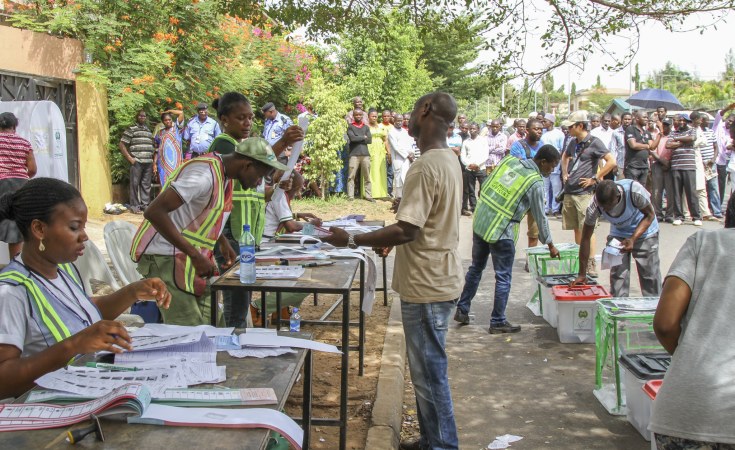The country's 2023 elections delivered a president, but the process was far from perfect.
Nigeria's presidential and legislative elections on 25 February were the country's seventh since the return to multi-party democracy in 1999. Eighteen presidential candidates took part.
Observers judged the poll to be the most competitive in Nigeria's history, departing from the previous two-horse race between the All People's Congress (APC) and Peoples Democratic Party (PDP). This time, former Anambra State governor Peter Obi led the hitherto minor Labour Party (LP) to become a potential third force.
Voting took place amidst widespread violence in all six geopolitical zones, including attacks on the Independent National Electoral Commission's (INEC) facilities. Contrary to expectations of an increased voter turnout, the election recorded the lowest-ever voter turnout of 27.1%.
Apart from violence in parts of the country, widespread delays in the opening and late closure of polls affected turnout. The INEC's decision to decongest polling units also created confusion and frustration. Although the commission sent messages to those affected, not all received the communications, leading to boycotts by some who struggled to locate their polling units on election day.
Observers judged the February poll to be the most competitive in Nigeria's history
Bola Ahmed Tinubu of the ruling APC was declared president-elect after winning 36.6% of total votes and 25% of ballots in 30 states. The outcome has been challenged by the main opposition candidates Atiku Abubakar (PDP) and Obi, who placed second and third. They cite widespread irregularities, especially in the collation of results. Both served notice to challenge the results in court after the INEC rejected their calls for cancellation.
Indeed, there were challenges with the collation and transmission of results. The 2022 Electoral Act legalised the use of the Bimodal Voter Accreditation System and INEC Results Viewing Portal. Both sought to increase transparency and deal with recurring problems of rigging and manipulation associated with accreditation and collation. At a time when citizens' trust in the INEC had waned, the innovations promised a credible electoral process.
But although the INEC piloted the Results Viewing Portal in 105 constituencies for several off-cycle elections, it wasn't deployed nationwide before the election. And while testing of the new voter accreditation system was laudable, analysts believe these exercises happened too close to the election. Also, the INEC used small samples of polling units and voters, and failed to adequately stress-test the systems.
Two critical functions were expected of the Bimodal Voter Accreditation System. First, accreditation of voters' biometrics - fingerprint and facial - at polling stations. Second, taking pictures of results forms and submitting them electronically, along with the total number of accredited voters, to the INEC's servers/central collation centre. The outcomes were to be released on the Results Viewing Portal for public access.
Despite the verification process working well during accreditation and voting, there were problems transmitting results on election day. Because internet coverage across the country is less than half (46.24%), the voter accreditation devices allowed results submitted offline to be released automatically when the device was connected to the internet.
Contrary to expectations, the election recorded the lowest-ever voter turnout of 27.1%
According to a report by Yiaga Africa, in 69% of polling units, the presiding officer attempted to send the results image to the INEC's online system. Yet the findings reveal that some ad hoc polling staff didn't try to immediately transfer the data after party agents endorsed counted results. This is surprising given the punitive measures enshrined in the Electoral Act 2022.
Even for successful submissions, images other than the declared results form were transferred on the Bimodal Voter Accreditation System in some cases. In others, polling staff sent blurred photos, perhaps because the system settings were incorrect or had been tampered with. The INEC ruled out the possibility that a system hack affected the quality of images released on the Results Viewing Portal.
Added to these problems was the INEC's inability to upload the declared presidential results form submitted on the viewing portal in near real time, as it had assured the public it would. By contrast, outcomes for the senatorial and national assembly trickled in. Shortly before midnight on election day, less than 5% of presidential declared results forms had been uploaded on the portal, and the uploads continued for three weeks after the elections ended. This heightened suspicion.
Before midnight on voting day, less than 5% of presidential results were uploaded on the viewing portal
Ideally, the Results Viewing Portal should have provided additional consistency checks, transparency and credibility, but the INEC decided to resort to manual collation. Although this decision was consistent with the Electoral Act 2022, it led to protests from major opposition parties, including the PDP and LP, and cast doubt on the credibility of the collation process.
In future, more diligence, transparency and accountability are required from the electoral commission to inspire public confidence in the process. The INEC should investigate and sanction non-compliant staff and enhance the training of its ad hoc staff, especially in handling the Bimodal Voter Accreditation System. Device settings should be standardised, and more robust stress checks undertaken on procedures long ahead of polling day.
A thorough analysis is also needed to assess the geographical sources of the blurred images on the Results Viewing Portal and how that affected results.
Mawusi Yaw Dumenu, Senior Programmes Officer and Team Lead, Elections, Ghana Center for Democratic Development and Coordinator, West Africa Election Observers Network and Enoch Randy Aikins, Researcher, African Futures and Innovation, ISS Pretoria


